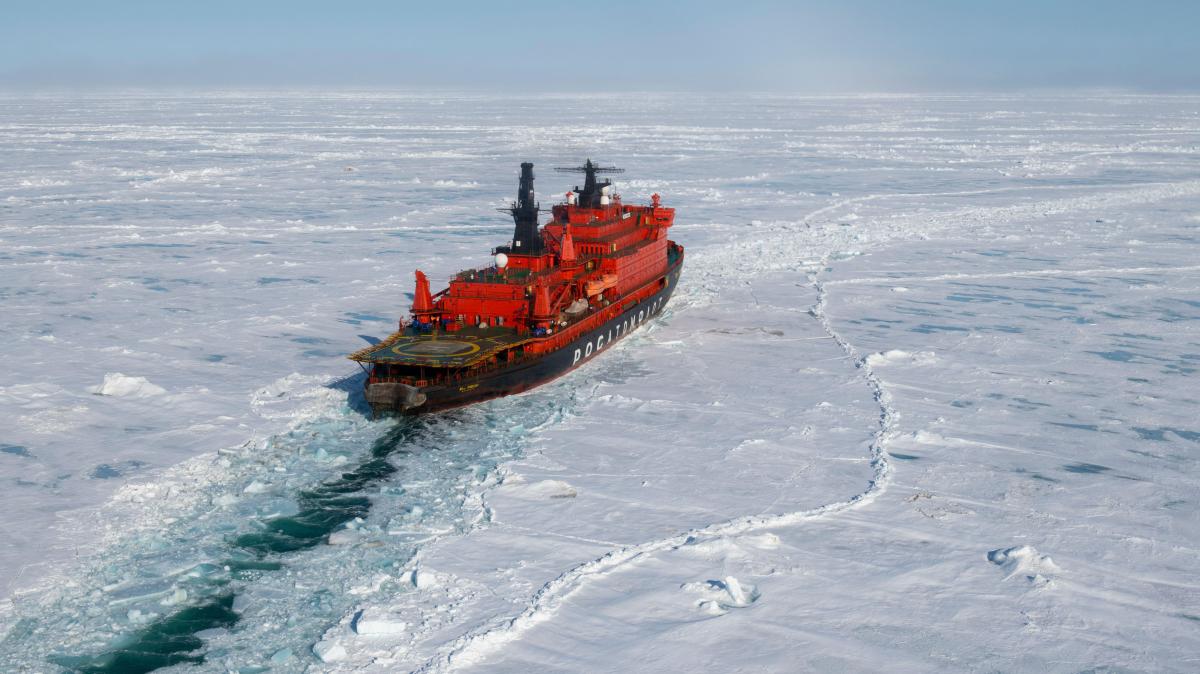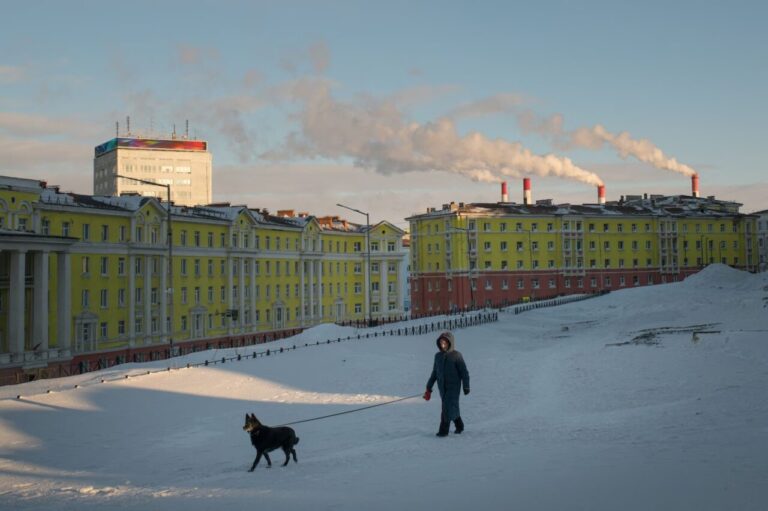By Marc Bennetts via The giant icebreaker Lenin now sits in a corner of the port of Murmansk, the world’s largest city within the Arctic Circle. From 1959 to 1989 this colossal vessel accompanied thousands of ships through over half […]
By Marc Bennetts via
The giant icebreaker Lenin now sits in a corner of the port of Murmansk, the world’s largest city within the Arctic Circle. From 1959 to 1989 this colossal vessel accompanied thousands of ships through over half a million miles of thick Arctic ice, the equivalent of a journey to the moon and back.
As befitted the world’s first nuclear-powered icebreaker, the Lenin was designed to impress. The pride of the Soviet merchant fleet, now a floating museum, it was fitted out with an elegant winding oak staircase and a grand piano in the spacious social room, where the ship’s crew would gather to sing during the long Arctic evenings.
A lot has changed since the Lenin’s heyday: as climate change accelerates, the formidable polar conditions that it was built to withstand are vanishing. The Arctic is warming up more than twice as fast as the rest of the planet: scientists say that by 2050, much of the region will be ice-free in summer. Russia’s meteorological agency said last year that the ice cover on the Arctic sea route had reached a record low.
For Russia, the rapidly melting ice sheets signal new opportunities for lucrative commercial shipping along the Northern Sea Route, a passageway from northern Europe to Asia that the Kremlin is touting as a faster alternative to the Suez Canal. The route, which stretches for thousands of miles along Russia’s Arctic coastline, can cut almost two weeks off a journey from Hamburg to Tokyo via the canal.
The project received a boost in March when the Egyptian canal was blocked for six days by a huge container ship.
The Northern Sea Route is a key element in Russia’s broader bid to develop the Arctic, although Moscow is planning a gigantic oil project in the region and the government recently announced a free land giveaway in a bid to stop depopulation. “The Arctic is a strategic territory for Russia. It gives us a whole host of new possibilities. We must master it,” Yury Trutnev, a deputy prime minister, said.
Cargo volumes on the route have already increased tenfold over the past decade, reaching 32 million tonnes last year. President Putin wants that figure to almost triple by 2024. Much of the cargo consists of oil, liquefied natural gas and other fuels from Canada, China and Russia. The dark irony that climate change caused by the world’s reliance on oil and gas has made it easier to transport these very same polluting fossil fuels through the Arctic has not been lost on environmental groups. The situation is akin to “a heavy smoker using his tracheotomy to smoke two cigarettes at once”, according to Greenpeace.
The receding ice means that voyages that once seemed like the stuff of science fiction are now a reality. In 2017, the Christophe de Margerie, a Russian-owned tanker, became the first ship to travel the Northern Sea Route without the help of icebreaking vessels. Arctic maritime records continue to tumble: this year, in February, a Russian gas tanker set a new landmark when it carried out the first successful voyage by a commercial vessel across the Northern Sea Route. in February. It completed most of its arduous journey on its own steam. Shipping for tankers along the route had previously ended in November each year and did not resume until July.
In October, the Arktika, a nuclear-powered icebreaker that is designed to smash through floes up to three metres thick, returned from its maiden voyage to the North Pole without being able to test its capabilities. The ice simply wasn’t thick enough. “The icebreaker experienced no resistance at all,” said Oleg Shchapin, its captain.
But the Kremlin is not content with the growing window for Arctic shipping: it wants the Northern Sea Route to stay open all year round, and has embarked upon an ambitious project to build new nuclear-powered icebreakers. While ice packs that have formed over many consecutive winters have all but vanished along the Russia’s Arctic coastline, drifting ice, which is often harder to spot, can create serious hazards for shipping.
“We believe navigation can be made year-round and we’re not waiting until it happens climate-wise,” Alexei Chekunkov, Russia’s minister for Arctic development, told Bloomberg. “We’re building the most powerful fleet of nuclear icebreakers in the world.” It is, in fact, the only such fleet in the world: no other country possesses even a single nuclear icebreaker.
In April, Putin hailed work on the Lider, a 673ft nuclear icebreaker made of “self-diagnosing” and “self-healing” materials that Russia plans to launch in 2027. Putin said the Lider, which will cost Russia around about £1.1 billion, was unlike any icebreaker ever constructed. Moscow plans to build three such vessels as part of its bid to boost Arctic shipping.
Environmentalists warn, however, that easier access to the Arctic’s waters comes with increased risks for the region’s fragile eco-system. “A spill of shipping fuel would be disastrous in the Arctic, and prove close to impossible to clean up, given the difficult conditions,” said Sian Prior, lead adviser at the Clean Arctic Alliance group. The growing number of vessels in the region also has unpredictable consequences for Arctic marine life.
“Ship captains and whales both prefer waters with the least concentration of ice,” said Alexey Knizhnikov of the World Wildlife Fund. “And this promises an increase in the risk of collisions, as well as noise and other activities that could negatively affect animals.”
Heavy fuel oil is an inexpensive, sludge-like residue that is used to power commercial ships. When burnt, it produces black carbon soot, a major contributor to climate change. It has been banned in Antarctic waters since 2011. After years of pressure by environmental groups, the International Maritime Organisation recently issued a ban on its use in the Arctic, but the prohibition does not come into effect until 2024 and it will not apply to Russia and other countries with Arctic coastlines until the end of the decade. Critics say the move will only result in a 5 per cent reduction in black carbon emissions.
The row comes as new research indicates that the warming of the Arctic could be causing changes to weather patterns that are responsible for unseasonably cold weather across Europe such as 2018’s Beast from the East snowstorms, as well as this year’s big freeze in Texas.
In contrast, Rosatom, the Russian state atomic company that oversees the Northern Sea Route, is touting increased shipping in the region as a partial solution to the problem of climate change. “Year-round navigation along the Northern Sea Route will prevent millions of tonnes of CO2 emissions just by cutting distances, travel times, and, effectively, the amount of fuel burned by ships,” the company said.
Alexey Kalinin, an academic who advises Rosatom on Arctic issues, said the use of alternative fuels such as liquified natural gas and methanol, as well as electric-powered vessels would minimise environmental damage.
Not everyone is convinced. In April, the Mediterranean Shipping Company, the world’s second largest container shipping line, declared that it would not send its vessels through the route. “Attempting to open new navigation routes which skim the polar ice cap sounds like the ignorant ambition of an 18th-century explorer,” said Bud Darr, the company’s vice-president.
Russia is planning its next steps carefully, said Mikaa Mered, an Arctic expert with Cevipof, a French research institute. “The Russians know that they can’t mess up, because they won’t have a second chance if they do,” he said. “This means it’s going to be some time before the Northern Sea Route is open year-round: it’s not just a matter of having big icebreakers.”





